
Cornelis Dusart stands as a significant figure in the later Dutch Golden Age, an artist whose work provides a lively and often humorous window into the world of 17th-century peasant life. Born in Haarlem in 1660 and dying in his hometown in 1704, Dusart was a painter, draughtsman, and printmaker who skillfully navigated the artistic currents of his time. He is perhaps best known as the most prominent pupil and successor of Adriaen van Ostade, inheriting not only his master's thematic focus but also his studio and unfinished works. Through his paintings, drawings, and particularly his prints, Dusart carved out his own niche, blending keen observation with a distinct flair for caricature and narrative detail.
Early Life and Apprenticeship in Haarlem
Cornelis Dusart entered the world in Haarlem, a bustling center of art production during the Dutch Republic's cultural zenith. His artistic journey formally began under the tutelage of Adriaen van Ostade, a leading master of genre painting, particularly scenes of peasant life. Dusart studied with Ostade from approximately 1675 until 1679. This period was crucial in shaping his technical skills and thematic preferences. Following his apprenticeship, Dusart achieved professional recognition by joining the Haarlem Guild of St. Luke in 1679. Membership in the guild was essential for artists wishing to practice independently, sell their work, and take on pupils within the city. This marked the official commencement of his career, firmly placing him within the established artistic community of Haarlem, a city that had also nurtured talents like Frans Hals and Jacob van Ruisdael.
Artistic Style and Influences
Dusart's artistic style is deeply rooted in the tradition established by his teacher, Adriaen van Ostade. He embraced the depiction of rural and village life, focusing on peasants in taverns, at markets, or engaged in various forms of leisure and labor. Like Ostade, Dusart often imbued these scenes with a sense of warmth and careful observation of human interaction. His figures, while sometimes coarse, are generally presented with a degree of sympathy or, more frequently, gentle humor. He inherited Ostade's skill in composition and the rendering of textures and light within rustic interiors and outdoor settings.
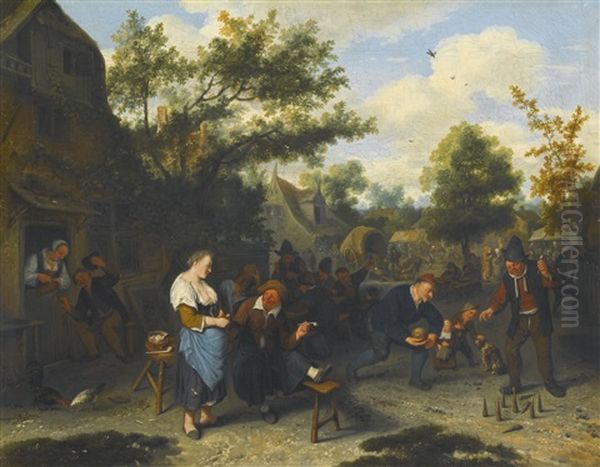
However, Dusart was not merely an imitator. He developed a distinct personal style characterized by a more pronounced tendency towards humor, satire, and even cartoonish exaggeration. Some scholars also note the potential influence of Jan Steen, another master of Dutch genre painting known for his lively, often chaotic, and morally didactic scenes. Dusart's figures can sometimes appear more robust or caricatured than Ostade's, and his narratives occasionally lean more heavily into comedic or satirical commentary on human foibles. He employed techniques like colored chalks and watercolors, particularly in his drawings, adding vibrancy to his depictions. His oil paintings often feature a rich palette, though sometimes leaning towards the browns and earth tones favored by Ostade.
Themes and Subject Matter
The core of Cornelis Dusart's oeuvre revolves around the lives of the common people, specifically the peasantry of the Dutch countryside. His works frequently depict scenes set in rustic taverns, where villagers gather to drink, smoke, play cards, or engage in games like tric-trac (a form of backgammon). These interiors are often rendered with attention to detail, showing worn furniture, simple pottery, and the interplay of light filtering through windows or emanating from candles. Outdoor scenes are also common, including lively village fairs (kermesses), market days, and peasants relaxing or working outside inns.
Dusart captured the boisterous energy of these gatherings, showcasing dancing, music-making (often featuring fiddlers or pipers), and the occasional brawl or amorous encounter. Works like Peasants Skittling Before an Inn (c. 1680-1690) exemplify his interest in outdoor leisure activities. He also depicted quieter moments, such as family life or specific occupations, as seen in The Schoolmaster (c. 1680-1690), which offers a glimpse into rural education. While often humorous, his work occasionally carries satirical undertones, gently mocking excessive drinking or foolish behavior, aligning with a broader tradition in Dutch genre painting that included artists like Adriaen Brouwer and David Teniers the Younger, whose works often contained moralizing messages alongside depictions of revelry. Religious themes appear less frequently but are present in his output.
Mastery in Printmaking
Beyond his paintings and drawings, Cornelis Dusart made significant contributions as a printmaker. He was proficient in etching and engraving, and notably skilled in the technique of mezzotint. Mezzotint, a tonal engraving method, allowed artists to achieve rich, velvety blacks and subtle gradations of tone, making it particularly effective for nocturnal scenes or dramatic light effects. Dusart utilized this technique masterfully, creating prints known for their atmospheric qualities.
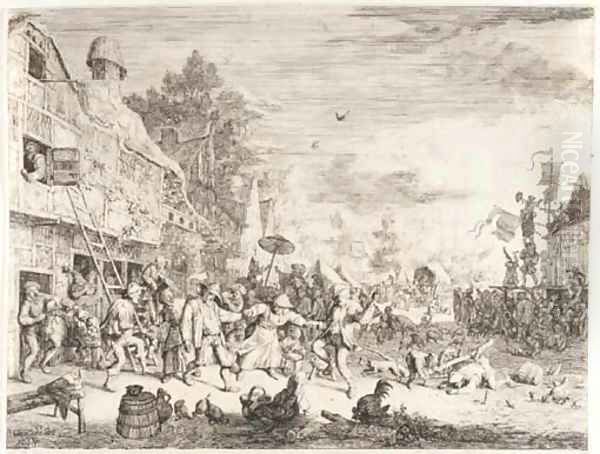
He produced a number of original print designs, including around fourteen etchings. His print series depicting the five senses, sometimes represented by men engaged in activities like smoking or drinking by candlelight (e.g., the Man Lighting a Candle series), showcases his command of light and shadow, rivaling even the chiaroscuro effects found in the works of Rembrandt van Rijn, albeit on a different scale and subject matter. His etchings often mirrored the subjects of his paintings, featuring peasant gatherings and tavern scenes, such as the print Tric-trac Players.
One of his most ambitious prints is The Large Village Fair (1685), a complex etching and engraving filled with numerous figures and anecdotal details, demonstrating his ability to handle intricate compositions with precision. Dusart also created designs for illustrations, some of which were executed by assistants or local publishers, further disseminating his style and imagery. His prints were popular and collected, contributing significantly to his reputation both during his lifetime and after.
The Legacy of Adriaen van Ostade
The relationship between Cornelis Dusart and Adriaen van Ostade extended beyond the typical master-pupil dynamic. When Ostade died in 1685, Dusart, as his leading pupil, inherited the contents of his master's studio. This inheritance included not only tools and materials but also a substantial number of unfinished paintings, drawings, sketches, and possibly etching plates. This event had a profound impact on Dusart's career.
He took on the task of completing many of Ostade's unfinished works. This practice, while perhaps seeming unusual today, was not uncommon in the 17th century. It speaks volumes about Dusart's deep understanding of his master's style and technique that he could seamlessly finish these pieces. Consequently, distinguishing between Ostade's late work, works finished by Dusart, and Dusart's own early independent works can sometimes be challenging for art historians. Some works completed by Dusart were subsequently sold, occasionally blurring the lines of authorship in the contemporary art market. This inheritance undoubtedly provided Dusart with material resources and artistic models, but it also cemented his position as the direct artistic heir to Ostade, continuing the tradition of Haarlem peasant genre painting.
Later Life, Collections, and Recognition
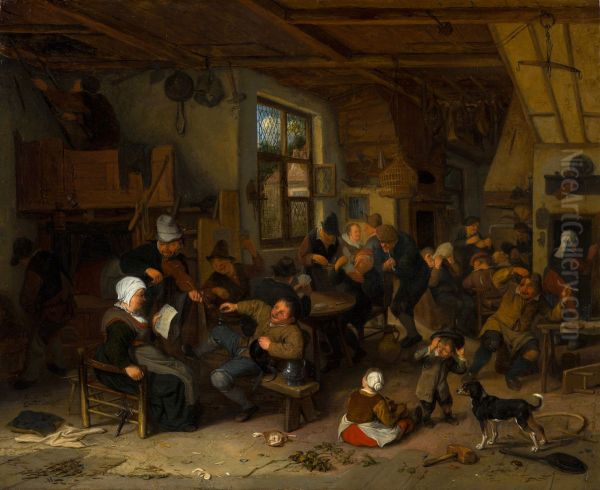
In his later years, Cornelis Dusart continued to be a productive artist in Haarlem. Beyond his own creative output, he became a collector himself, acquiring works by various Italian and Dutch artists, indicating his engagement with the broader art world. His personal collection likely served as both an investment and a source of inspiration. Sources suggest he played a role within the artistic community, although reports of him heading the Amsterdam Guild of St. Luke in 1692 require careful consideration, as his primary affiliation was strongly with Haarlem. His documented membership in the Reformed Church from 1682 also points to his integration into the social and religious fabric of his community.
Dusart's works found a ready market during his lifetime and remained popular after his death. His paintings, drawings, and especially his prints were sought after by collectors. The humorous and relatable nature of his peasant scenes appealed to the tastes of the Dutch middle class. His technical skill, particularly in printmaking, ensured his reputation among connoisseurs. The fact that some of his works were occasionally misattributed to Adriaen van Ostade or even Adriaen's brother, Isaac van Ostade (also a painter of genre scenes), underscores the high quality of his output and his stylistic proximity to his master, while also highlighting the complexities of attribution in the 17th-century art market.
Notable Works
Several works stand out as representative of Cornelis Dusart's style and thematic concerns:
Peasants Skittling Before an Inn (c. 1680-1690): This painting captures a lively outdoor scene, showcasing Dusart's ability to depict animated figures engaged in leisure within a detailed village setting.
The Schoolmaster (c. 1680-1690): Offering a different perspective on rural life, this work focuses on a scene of education, rendered with characteristic attention to character and environment.
A Debauched Man Wielding a Knife (Held at Boijmans van Beuningen Museum): This work, likely dating from his mature period despite the potentially confusing notation of his birth year (1660) sometimes associated with it in sources, exemplifies the more boisterous and potentially satirical side of his art, rendered in a palette emphasizing dark tones with highlights.
The Large Village Fair (1685): A major work in his printmaking oeuvre, this etching/engraving is a tour-de-force of complex composition and anecdotal detail, depicting the bustling energy of a rural festival.
Peasants Drinking Before Gambling (1691, held at Musée du Louvre): This painting portrays a festive gathering outside a tavern, typical of his interest in peasant revelry and social interaction.
Tric-trac Players (Etching, Rijksmuseum): A fine example of his etched work, focusing on an indoor tavern game, showcasing his skill in depicting figures and interiors in print.
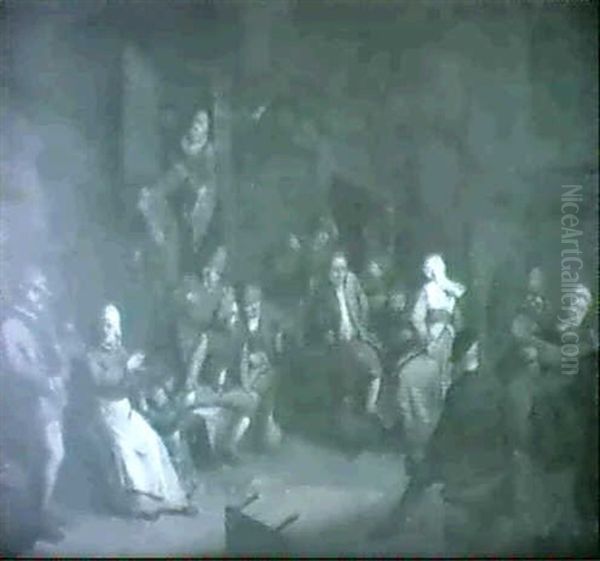
Tavern-Goers Playing Backgammon and Merrymaking (Drawing, J. Paul Getty Museum): This drawing highlights his skill as a draughtsman, capturing the lively atmosphere of a tavern scene with fluidity and character.
Peasant Inn (Print, Mauritshuis): Another print focusing on the quintessential Dusart theme of the village inn and its patrons.
These works, among many others, demonstrate the range of Dusart's talent, from detailed oil paintings to expressive drawings and technically accomplished prints.
Collections and Provenance
Works by Cornelis Dusart are held in numerous prestigious museums and collections worldwide, attesting to his enduring appeal and historical importance. Key institutions include:
Rijksmuseum, Amsterdam: Holds significant prints, including Tric-trac Players.
Boijmans van Beuningen Museum, Rotterdam: Houses paintings like A Debauched Man Wielding a Knife.
Musée du Louvre, Paris: Features paintings such as Peasants Drinking Before Gambling.
J. Paul Getty Museum, Los Angeles: Possesses drawings like Tavern-Goers Playing Backgammon and Merrymaking.
Mauritshuis, The Hague: Includes prints like Peasant Inn.
Beyond these major public collections, Dusart's works frequently appear on the art market, handled by major auction houses like Christie's and Sotheby's in London and New York. Historically, his drawings and prints were part of notable private collections, such as those belonging to S. J. Stinstra de Harlingen and the Barons van Duvenvoorde, indicating a long history of appreciation among discerning collectors. The presence of his works, including paintings, drawings like Grande festa paesana (1685, a colored watercolor), and various prints, in both public institutions and private hands across Europe and North America confirms his status as a recognized master of the Dutch Golden Age.
Art Historical Significance and Context
Cornelis Dusart occupies a specific and important place within the rich tapestry of Dutch Golden Age art. As the foremost student and successor of Adriaen van Ostade, he played a crucial role in continuing the Haarlem tradition of peasant genre painting into the late 17th century. While the towering figures of Rembrandt and Vermeer explored different facets of human experience and artistic technique, and landscape painters like Jacob van Ruisdael captured the Dutch environment, Dusart focused intently on the everyday lives, labors, and leisure of the rural population.
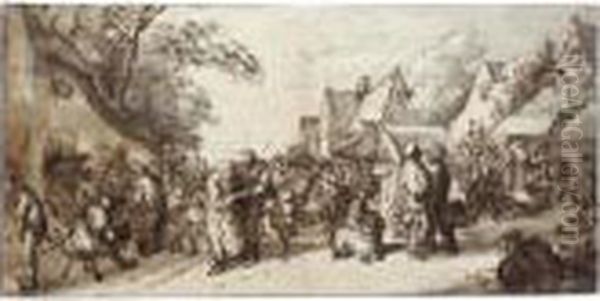
His contribution lies not just in perpetuating Ostade's themes but also in infusing them with his own distinct personality, marked by heightened humor and a tendency towards caricature. His skill in printmaking, particularly mezzotint, allowed him to explore dramatic lighting effects and reach a wider audience. Compared to the often more idealized or refined genre scenes of artists like Gerard Dou or Gabriel Metsu, Dusart's work maintains a connection to the earthier, sometimes cruder, depictions of peasant life seen earlier in the work of Flemish artists like Adriaen Brouwer or Pieter Bruegel the Elder, yet filtered through a distinctly Dutch sensibility.
The issue of misattribution surrounding his work highlights the collaborative nature of workshops and the complexities of artistic identity in the period. However, his substantial body of independent work, characterized by technical skill and a unique observational humor, secures his position as a significant artist in his own right. He effectively bridged the style of his master with his own innovations, ensuring the vitality of the peasant genre tradition as the Golden Age drew to a close.
Conclusion
Cornelis Dusart remains a captivating figure in Dutch art history. Emerging from the shadow of his renowned master, Adriaen van Ostade, he forged a successful career as a painter, draughtsman, and printmaker. His depictions of peasant life, characterized by humor, keen observation, and technical proficiency, offer invaluable insights into 17th-century Dutch society. Through his inheritance and continuation of Ostade's studio and style, he ensured the longevity of a specific Haarlem tradition. Yet, with his unique flair for satire, his mastery of printmaking techniques like mezzotint, and his prolific output, Dusart established his own artistic identity. His works continue to be appreciated in collections around the world, celebrating his role as a skilled chronicler of the everyday joys and follies of the Dutch Golden Age peasantry.